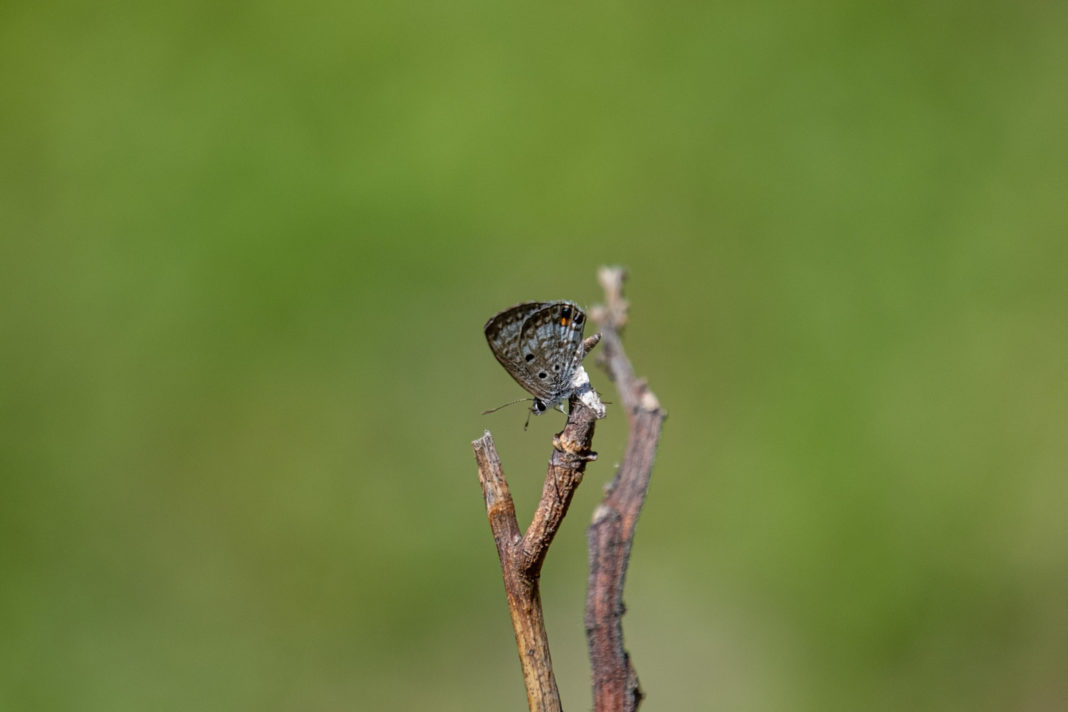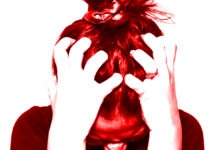If you want to find a Miami blue caterpillar the first thing you do is look for the gray nickerbean. You could also look for Keys blackbead, but Keys blackbead can also be the host plant for the Cassius blue butterfly and their larvae look pretty much the same, so you wouldn’t be sure what you were looking at. It’s better to find the nickerbean, because Miami blues are the only butterflies that use it as a host.
After you find that, look for a Florida carpenter ant. They’re a kind of ruddy brown, which makes them easier to find against the green of the nickerbean. Look for an ant that’s a little crazed, a little hyper, running back and forth, spinning around, maybe somewhat spastic, as if it’s on some kind of sugar high. Because it is. Watch it long enough and it will run back to a small, elongated lump on the stalk, about half the size of a grain of rice. The ant will touch the small lump, then start sprinting around again.
Florida carpenter ants and Miami blue caterpillars have a symbiotic relationship that seems part protectionist racket, part addict/dealer relationship. The caterpillar has a gland that secretes something unofficially called honeydew, a sugary substance that the ants can only get from them. In exchange for the regular hits of honeydew, the ant gets proprietary and fends off all the other ants, wasps and spiders, basically acting as bodyguards who are in it for the fix. The elongated lump that the ant keeps running back to will be the Miami blue caterpillar.
It will be pretty much the same wasabi green as the nickerbean stalk, but stare at it long enough and you’ll realize it is moving at a slow, processional pace, like a train viewed from a distance as it passes through a vast and scenic landscape. It will either be moving out toward the new growth at the end of a branch, or back in toward the thicker parts of the branches, seeking the shortest route to a new batch of new growth to chomp.
I learned all this the other day from Taylor Hunt when I met him at Bahia Honda State Park. The nickerbean we were staring into was at the foot of the incline to the old Bahia Honda Bridge. Hunt is a field technician for the McGuire Center for Lepidoptera & Biodiversity at the Florida Museum of Natural History. But it’s hard not to see him as something of a butterfly shepherd – butterflyherd? – for the Miami blue. Among other tasks, he monitors their population, collects data, creates new habitat and works with staff at the University of Florida to breed them in captivity to release them into the wild.
Why all this work? Because the Miami blue is endangered and once thought to be extinct.
It’s a coastal species, and its range once extended from Cape Canaveral down to the Keys, and back up on the Gulf side to Sarasota. They were so common no one really bothered to study them. And then in the ’80s people noticed they were disappearing from the landscape, their population crashing due to widespread development. Their last known colony was in Key Biscayne, and it disappeared after Hurricane Andrew in 1992.
No one saw any Miami blues until 1999, when a small colony of 25 butterflies was discovered at Bahia Honda. That colony disappeared in 2010, but other small colonies were discovered in Key West Wildlife Refuge, and a captive breeding program started in an attempt to bring them back.
“We’re trying to elucidate as much as we can about the life cycle of these guys. And it’s difficult,” Hunt said. They are trying to figure out ways for them to thrive once more.
I told Hunt the whole ant-and-caterpillar thing was really cool, as I’d never seen a Miami blue caterpillar. And though I’d known about them for years, I’d never seen an actual Miami blue butterfly, either. He pointed one out immediately, though it took a bit of direction on his part for me to see it, even though it was briefly sitting still on the end of a snag. Then he pointed out another, and another, and I slowly caught on. There were dozens of them. Hunt said this was actually an incredibly busy day for Miami blues, that he hadn’t seen this many wild ones at once in a long time.
“Normally I’ll be happy to see a couple Miami blues here amongst dozens of Cassius (blues). These are mostly all Miami blues. It’s just absolutely fantastic,” he said.
The butterflies we were looking at came to be through a captive breeding program, but had descended several generations past the ones that were released.
The adult Miami blue – the butterfly – is a lot bigger than the caterpillar, but still pretty damn small. With their wings spread, you could lay one out on a quarter. Wings folded, they’d fit on a dime. The blue that gives it the name – a silky, cerulean blue – is on the upper part of the wing. The underside is an otter brown with a white band at the edge and four black spots at the base.
The Miami blue mostly keeps its blueness to itself. It flaps faster than you can see, so in the air its colors tend to merge into a pale cornflower hue, and when it lands, it tends to fold its wings so all you see are earth tones. Hunt said that early in the morning, or toward sunset, if they want to warm up some, they may spread their wings, giving folks a look at the blue.
Their flight speed during their butterfly phase is almost inversely proportional to their slowness as caterpillars. They are so fast they are hard to track moving through the air, even if they don’t move very far.
“If they’re not flying around like maniacs, they’re just gonna get gobbled up by something. I’m sure that’s why they never really chill out,” said Hunt.
As we walked along the base of the berm, we saw dozens and dozens more of them.
“I can’t tell you how happy I am right now,” Hunt said. Later he added, “This is like Disney-level perfect. Just clouds of the endangered species the interviewer wanted to come talk about.”
“Well staged,” I said, as if such a thing could be.



















